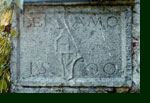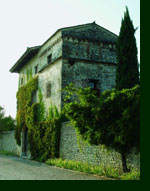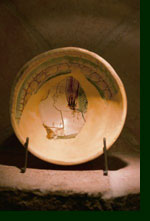“In Bergamo Parvo in Patria Fori Julii: un sito fortificato presso
l’attuale territorio comunale di Torreano”
Summary taken from "Motivi di storia locale e dell'ambiente del
Comune di Torreano di Cividale" (Historical Notes Concerning the Town of Torreano di
Cividale)
by Maurizio Grattoni d’Arcano
(for
historical traces visit our photo gallery)
Up to now, the history of this fortress was summarized in a few dates spanning through several
centuries:
Two uncertain references found in historical documents dated 1275 and 1300;
No other reference until “1500”, when the year appears beside the word “Bergamo” on a walled
tablet in the buttress. of the “domus”;
No other reference is made until 1770, when the entire property was sold by Beltrame Calderini
to the brothers Giovanni Battista and Domenico Serafini.
It is this very document that leads the reader to mistakenly believe that Bergum belonged
historically to the Calderini family who, on the contrary, became owners of the property for a
little over two decades, from 1748.
Upon examination of the purchase contract and documents which led to the notary, Marc’Antonio
Tracanelli, as well as the examination of other historical documents, we found a conspicuous
amount of information which helped us outline the history of Bergum from the beginning of the
Sixteenth Century, as well as the history of the family who owned it before the Calderini
family:
the Leale family, a noble family from Udine.
The family was originally from the town of Cornoleto near San Giovanni Bianco in Val
Brembana, in the Bergamo district. In fact, a first reference to the family of the
brothers Francesco and Cristoforo, is dated 1502. In this document the brothers are
referred to as being “cives” or citizens of Udine and sons of the late Sir Giovanni Lialis de
Raspis, di Cornoleto.
The first reference that Bergum was the property of the Leale Family dates back to 1525,
although the document mentions that it was their property before this date.
The name “Bergum” could then very well have been given to the fortress in memory of the native
town of the family.
But two medieval
references add to the confusion concerning the origins of Bergum.
In fact, the name “Bergona” appears in several documents concerning properties located
in Eastern Friuli, not far from the fortress itself. As we will see, Bergum clearly
presents architectural characteristics which date before the Sixteenth Century:
The two names referring to the fortress could therefore be plausible but not thoroughly proven
since no documents referring to the fortress before the Sixteenth Century have yet been found.
 The two tablets still
present in the manor wing could have been posed by the Leale brothers, Francesco and
Cristoforo. One of them bears the incision of the year ”1500” and the word “Bergamo”, and
seems to be a mercantile incision, while the other more elaborate one and placed at the
centre of the façade is clearly a noble coat of arms. The fact remains that this coat of
arms is not the one belonging to the Leali family, who became part of the Udine nobility
in the Sixteenth Century. The two tablets still
present in the manor wing could have been posed by the Leale brothers, Francesco and
Cristoforo. One of them bears the incision of the year ”1500” and the word “Bergamo”, and
seems to be a mercantile incision, while the other more elaborate one and placed at the
centre of the façade is clearly a noble coat of arms. The fact remains that this coat of
arms is not the one belonging to the Leali family, who became part of the Udine nobility
in the Sixteenth Century.
|
The Leale family becomes extinct upon the death of Caterina, the widow of Nicolò Calderini.
Her heirs sell the entire property to the Seraffini brothers, Giovanni Battista and Domenco,
owners of the Ziracco villa, on July 2nd 1770.
From then on, Bergamo belongs to the Seraffini family.
These are the proven historical documents in our possession referring to Casaforte di Bergum.
We do still have doubts concerning the origin of the fortress which surely dates before the
Sixteenth Century and represents a rare example of fortified agricultural property in Friuli.
Today Bergum is made up of a wall surrounding the manor, several smaller buildings and a
tower originally annexed to the ancient entrance and now on the southwest corner of the wall.
The tower was originally positioned more towards the left of the building. The fortress
also has an ancient lowered arch.
Bergum is square shaped: two sides with buildings and the other two sides contain the
walls of the fortress.
Traces of an outer wall have emerged from the fields cultivated around the fortress.
 The top of the Tower
is decorated with an arch in plastered brick, followed by a line of plastered dentils
with a lower frescoed ornament , representing festoons of green leaves tied together
with thin red ribbons. The top of the Tower
is decorated with an arch in plastered brick, followed by a line of plastered dentils
with a lower frescoed ornament , representing festoons of green leaves tied together
with thin red ribbons.
Even if the windows of the facade of the Domus date back to the end of the Fifteenth
Century or to the first years of the Sixteenth Century (it is possible that the incision
“1500” on the tablets was added on during a renovation of the fortress), the pictorial
and decorative characteristics of the fresco discovered during recent renovation and the
ornamental decorations on the Tower, are decisively Fifteenth Century.
|
 It is also important to
consider that the fragment of the fresco was found on a wall of what is today the “historical”
kitchen, during the emptying of the vaults in this room. It is also important to
consider that the fragment of the fresco was found on a wall of what is today the “historical”
kitchen, during the emptying of the vaults in this room.
|
 It therefore appears to be
clear that the vaults were constructed after the fresco. It is also clear that the rooms
which were described as being non residential in a document dating back to the Eighteenth
Century were actually residential during the preceding centuries. It is thought that the
rooms were also used for entertaining if you consider the fresco of the Lion of Saint Mark which
decorates the room. It therefore appears to be
clear that the vaults were constructed after the fresco. It is also clear that the rooms
which were described as being non residential in a document dating back to the Eighteenth
Century were actually residential during the preceding centuries. It is thought that the
rooms were also used for entertaining if you consider the fresco of the Lion of Saint Mark which
decorates the room.
Ceramics with Venetian influence , also considered to be of Fifteenth Century origin were also
found during the renovation of the vaults, along with a strange wooden clog possibly belonging
to a child because of its small size.
|
Further research helped us in our search for the name of the owners of the fortress before the advent
of the Leali family.
The following evidence seems important to us:
First of all, the “villa” (village) layout of the site has been maintained throughout the centuries.
This presumes that the number of inhabitants and dwellings were much higher than what is apparent to
us today. This theory is confirmed by the presence of foundations of other large buildings
which resurfaced during recent excavations.
Second of all, the existence of the acquisition of the right to the ""quartese", which the family
possessed since 1506, and was then handed down through the centuries to the Serafini family.
But the most important evidence is the following:
From ancient times, the site was under the jurisdiction of the Cucagna Family, whose castle,
although distant several kilometres (above Faedis) from the site, stands right in front of the rear
of the domus.
In fact, in the investiture renewal request made in 1682 by the noble Partistagno brothers,
Fancesco, Baldissare and Ludovico, declare that they possess: “a part of the Cucagna castle
now in ruins as well as the “villas” Faedis Ziraco Siaco Magredis Bergum”.
The fact that Bergum is included in the list of possessions pertaining to the original castle leads
us to presume that this was a feudal property owned by the Partistagno family before they entered
into the castle (bearing the same name) which came into their possession around the Twelfth Century.
Furthermore, in fairly recent times, numerous land properties in the area belonged to various
branches of the family. We can therefore not exclude that, in the medieval period, the “possession”
was included in the list of properties belonging to the ancient feudal family. At the
beginning of the Sixteenth Century, it became the property of the Leali family who renamed it
“piccola Bergamo”, in honour of their homeland.
top
|

